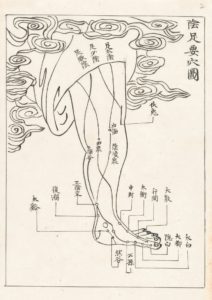Chinese Medicine Series 07:
Explanations of Channels and Points Vol.1

The following post is an excerpt from《Explanations of Channels and Points Vol. 1》 [经穴解] from the chapter called ‘Introduction to Explanations of Channels and Points’ translated by Michael Brown and edited by Allen Tsaur:
Explanation of the Names:
Explanations of Channels and Points is the earliest extant work that attempts to understand and rationalise the points name.5 For Tōng Li 通里 (HE-5), Yuè analyse both characters of the point name and offer his explanation as to why this point is named as such:
The previous point is Líng Dào (Spirit Pathway). Dào (Pathway), it is a road. This point is Tōng Li (Communicating Lane), Li (Lane) also means a road. As this point diverges to Tōng (Communicate) with the hand tàiyáng, there must be a road that Tōng (Communicates) them, therefore it is called Tōng Li (Communicating Lane).
For some points, he employs the anatomical understanding to see points as reflection of natural landforms within the body. For example, in Yáng Xī 陽谿 (LI-5), he explains:
The wrist crease has three points in it; the small intestine channel has Yáng Gǔ (Yáng Valley), the sānjiāo channel has Yáng Chí (Yáng Pool), and the large intestine channel has Yáng Xī (Yáng Ravine). These [names] adopt the meaning of flowing water, because these three points are all in places where [they] depart from the wrist to ascend the arm. Yuè’s thorough attempt to understand and define the names of all the acupuncture points was the first of its kind and was unrivalled for ages to come, and it has since inspired many similar writings to follow.
Discussion of Anatomy:
Explanations of Channels and Points provides crucial understanding to anatomy and locations of points. Yuè’s commentary on Fèi Shù 肺腧 (BL-13) provides a viable and reasonable explanation regarding the back transport points, to which he states:
On the back, the five zàng-viscera and six fu-bowels all have connectors, which connect to the back’s fatty network that clasps the spine. As for the [back] transport points, [their locations] are determined by the relative height of the zàng-viscera and fu-bowels.
He then continues to elaborate on the theoretical reasoning to why the locations of Dà Cháng Shù (BL-25, Large Intestine Transport) and Xiao Cháng Shù (BL-27, Small Intestine Transport) do not reflect the internal anatomy; to which he states:
Supposedly, Xiao Cháng Shù (BL-27) should be located above and Dà Cháng Shù (BL-25) should be located below, as it is the relative position of the large [intestine] and small intestine in height sequence; however, the lung is located above the heart. The lung and large intestine are an exterior-interior [pair]; for this reason, it is appropriate that Dà Cháng Shù (BL-25) is also located above Xiao Cháng Shù (BL-27).
From these two examples, we can see Yuè was able to use Chinese medical theory to explain otherwise problematic locations.

Would you like to subscribe to our newsletter?
If you enjoyed reading this please consider supporting us!
When we started the Purple Cloud Institute, our aim was to make accessible educational material about traditional Chinese cultural practices. We strive to keep prices of our books as affordable as possible and the content we provide free of charge. However, there are many ongoing behind the scenes costs and the time taken to provide such content is considerable.
If you have enjoyed our offerings please consider donating and supporting us. The help will allow us to make time to bring you more in the way of book publications, podcasts and videos about tradition-based Daoist, Chinese medicine and martial arts and help keep these traditions alive.
Your assistance is greatly appreciated!
